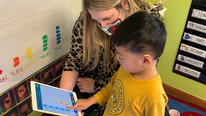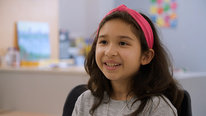- Leiny Garcia
- Graduate Student
- Elementary Computing for All
- https://www.elementarycomputingforall.org/
- UC Irvine, University of Chicago, Santa Ana Unified School District
- Dana Saito-Stehberger
- Research Specialist
- Elementary Computing for All
- https://www.elementarycomputingforall.org/
- UC Irvine, Santa Ana Unified School District
Facilitators’
Choice
Choice
Public Discussion
Continue the discussion of this presentation on the Multiplex. Go to Multiplex








Leiny Garcia
Graduate Student
Hello everyone,
The ECforALL project is a Research Practice Partnership between UC Irvine and Santa Ana Unified to develop a district-wide, Computational Thinking curriculum for upper elementary students starting in 4th grade. The goal is to develop a curriculum that supports the multilingual and culturally diverse students in the district as well as its teachers.
The curriculum will continue to expand to more districts and classrooms in Southern California for the next school year, including the development of a 5th grade curriculum. We would love to hear your thoughts on the efforts to bring CS education in the elementary level!
Additional Note: We currently serve a district that doesn't have specialists dedicated to computer science or tech. All our teacher participants are new to computational thinking, coding, and Scratch when they join the initiative. The curriculum is meant to support novice CS teachers in addition to students.
Alejandra Duarte
Emily McLeod
Director of Teaching and Learning, Code.org
Thanks for sharing your project, Leiny! You mentioned that participating teachers are new to computational thinking and coding – did they receive any professional development as part of the project? I appreciated that your video discussed some of the impacts of your work on students, and was wondering whether you looked at any impacts on teachers as well. Do you have any data on whether they are planning to continue using the curriculum in their classrooms?
Leiny Garcia
Leiny Garcia
Graduate Student
Hello Emily,
Thank you for stopping by :D We provide a summer PD and continue to support our teachers during the school year with monthly meetings. The early stages of the project did not focus on teacher impact, but moreso understanding instructional needs of our teachers to improve the curriculum (through observations and teacher interviews). However, this year we implemented the Teacher Beliefs about Coding and CT survey developed by Rich et al. (2020) as a pre and post test - look out for a paper on that soon!
We do not have confirmed data on continued use of the curriculum at hand but that is a great question! We currently have educators who have been involved in our initiative for two/three years, however, we did lose teachers who were overwhelmed by school demands under the pandemic.
Emily McLeod
Director of Teaching and Learning, Code.org
Thanks for your response, Leiny! Look forward to reading the paper when it comes out.
Roxana Hadad
Associate Director
Hi Leiny! The curriculum this project generates will be so useful to so many students! I'd love to learn more about how the curriculum is culturally relevant and/or uses linguistic scaffolding. Can you share examples of how this plays out in the classroom?
Leiny Garcia
Graduate Student
Hello Roxana,
Thank you for stopping by! To support our multilingual students, we follow the STEM Instructional Strategies developed by the National Academic of Sciences* (NASEM, 2018) designed to ensure the support of multilingual students designated as English Language Learners. Among those strategies is for instruction to focus on how language functions in CS. We embed resources in the curriculum for teachers to highlight that with their students, such as the use of language or sentence frames. The the last lesson of each unit has students reflect on specific aspects of their coding experience, such as debugging, and provide feedback to their peers with the help of language frames to guide their use of terms and how to break down their thoughts.
*National Academies of Sciences, E., Francis, D. J., Stephens, A. (2018). English learners in STEM subjects : transforming classrooms, schools, and lives.
As for culturally relevant approaches, we focus on opportunities for identity development. For example, we have an activity in each unit called Role Models where students learn about current and past computer scientists that reflect students diverse background. Students watch a video that describes the journey and occupation of the computer scientist. They then reflect on lessons they learned from the video and at times discuss the historical context of the time such as with Ada Lovelace and Dorothy Vaughn.
Dana Saito-Stehberger
Research Specialist
Hi Roxana,
Here is a link to Role Model videos and workbook pages that Leiny mentioned and that exist in our curriculum so far:
https://www.elementarycomputingforall.org/role-...
Here is a link to examples of how sentence frames have been provided to support learning activities in the curriculum.
https://drive.google.com/file/d/1H265Bsdaw1ttZG...
Victor Minces
I love this work.
Two questions: How does it scale up?
Are the results published? If so, could you provide a reference?
Thanks
Dana Saito-Stehberger
Research Specialist
Hi Victor!
I just watched your video. We share the important aim of creating an environment where all students feel empowered and able to be a contributing part of the STEM fields. It is encouraging to meet like-minded people.
Our initial scaling up plans have been altered, largely due to the disruption caused by COVID. This coming year our curriculum will be taught for the first time at a school district with 95% Hispanic/Latino students. Other schools across the United States will continue to teach the curriculum. Additionally, we are currently up-grading our curriculum website so that any teacher who is interested in teaching the curriculum can access it with ease. We hope in the future to provide free professional development as well.
Most of our publications on this project can be found at the following link: https://www.elementarycomputingforall.org/resea...
Victor Minces
Thanks so much Dana
Jan Cuny
Dir DEIA for Strategy and Operations
Nice project! I too was interested in the teacher training. How many teachers have you worked with? How long do you imagine it will take for a new teacher to come on board? Do your teachers typically start with any CS background? Once their training is complete, do they continue to work together?
Your age group is probably too young but you might want to look at Road Trip Nation's video: https://roadtripnation.com/roadtrip/computer-sc... .
Dana Saito-Stehberger
Research Specialist
Hi Jan!
We have trained about 50 teachers over the past 5 years. One unexpected benefit of COVID is that is allowed our team (in Irvine, Chicago, and San Francisco) to conduct one combined virtual summer PD for our teachers. Most teachers do not have any CS background. Our Summer PD has varied over the years. Teachers have taught after one week of intensive (40 hour) in-person professional development. In 2020, PD was conducted on Zoom and Google classroom for 2 weeks with 9 hours of synchronous instruction. Last year, PD was five weeks. We met synchronously for 6 hours and teachers watched videos and worked on projects for 10 hours. This year will will meet for 6 weeks. We will meet 14 hours synchronously. We will provide an extra incentive of 3 units of continuing education. We believe the extra time investment will pay off in confidence when teachers are in front of the class.
We conduct a monthly teacher meeting where teachers share successes and frustrations. It is also a good time to highlight relevant parts of the curriculum. Some teachers are the only ones teaching the curriculum at their school, so it is important that they have community to interact with.
Jan, thanks for sharing the Roadtrip Nation link! What a fantastic idea and an important resource. It looks like the headquarters is right around the corner from us. Much appreciated.
Kate Coleman
I really enjoyed your video and learning about your project work. The project that I'm working on, Math+C, has similar goals in broadening participation in programming at the elementary level. One question that I have is when, during the school day, do teachers teach your curriculum? Is it integrated into the existing curriculum?
It is interesting when you mention the challenges presented by Covid. We have faced similar ones—and have found ways to pivot to use our programming microworlds virtually with students (and teachers). It certainly wasn't the plan when we started, but it has been great to see how flexible our work has been able to be.
Thanks again for sharing!
Dana Saito-Stehberger
Research Specialist
Hi Kate-
Thank you for reaching out! It is interesting how forced pivots have created new and sometimes better ways of doing things. And forums like these can help us share what we've learned.
Teachers do teach our curriculum during the school day. One aspect of our study is to compare math and English scores of students who received our curriculum (and who received one hour less of ELA instruction per week) with students who did not receive our curriculum. We have found that students who have received our curriculum have done as well or better on those standardized tests.
Jacob Wolf
Like Jan's question above, I'm interested in how you worked with teachers with little to no prior CT experience. Our project is working on a slightly different topic with middle school students (Integrating computational modeling into science classrooms), but one big part of this has been helping teachers gain experience and confidence in teaching CT as part of a computational modeling practice. Have you found any approaches/activities/insights that have helped teachers who do not have as much experience with computational thinking begin teaching CT in their classrooms? We have also been running regular monthly teacher meetings to help build a community of support. Have you found any practices during these meetings to be particularly helpful in making teachers more comfortable teaching this new curriculum?
Dana Saito-Stehberger
Research Specialist
Hi Jacob-
It is challenging to train multi-subject teachers to teach CT. To provide more support to teachers, we enhanced the curriculum by creating slide decks and screenshots of each slide in each of the 20 lesson in the teacher’s guide. For particularly important information, we provide scripts for teachers to use. Most of the time, however, we provide general instructions to guide the teacher’s instruction. We have teachers who have taught without the slides and teacher’s guide and they have commented on the difference that they make.
For the 2022 Summer PD, we have included 2 new activities to hopefully encourage teacher confidence. First, after seeing each lesson modeled, teachers will choose part of a lesson that seems intimidating to teach and will have the opportunity to present a mini-lesson in front of a small group. We hope the other teachers will provide feedback and encouragement. The second activity will be giving a group of teachers a scenario of a problem/issue that has occurred to teachers while teaching the curriculum. These scenarios may be classroom management focused, or common misconceptions . . . .etc. Teachers, joined with a facilitator, will discuss possible solutions to the issues. We can report next year how well these learning activities worked! (Or, we can keep in touch and I can let you know how they went :))
As far as the teachers meetings go, I think it strengthens the community to hear the struggles, and successes, that teachers are having. Teachers have to feel comfortable in the group before they share what is really going on. Fortunately, we have a core of teachers who are all in the same district and who have been teaching our curriculum for a couple of years, so teachers are fairly familiar with each other. We have seen what a difference it makes to have two teachers teaching at the same school site!
Jacob Wolf
Jacob Wolf
Thanks for this very detailed response, Dana! I've recorded these ideas so we can hopefully integrate them into our upcoming PD sessions. :) It would be great to keep in touch, we can let you know how the activities work for us as well!
Also, we're getting ready to revise our teacher materials, and I just looked through some of yours at a link you posted above. Yours look very detailed and well-organized and will be a great example for what we want to work towards.
Alan Peterfreund
Lenny and team. Nice presentation. Are there any plans to collect any longitudinal data of the participants or track district/school data that can illustrate subsequent engagement in computing education?
Dana Saito-Stehberger
Research Specialist
Hi Alan -
No, unfortunately, we do not have plans to collect longitudinal data of the participants. Tracking district/school data to illustrated subsequent engagement is a great idea. We will consider our possibilities. Thank you for your thoughts!